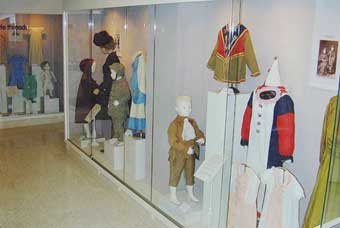|
|
Introduction
Our vision of childhood has changed over the years, and these
changes have been visible in how we dress our children. This
exhibition, mounted in spring 2001 by visiting fellow Susan
Green, documents the ways in which dress has reflected changes
in how identity and reality is experienced by children. |
 |
 |
Facing
Winter
Until our era of ubiquitous central heating and car heaters,
there was no such thing as a warm bedroom or cozy travel.
Keeping warm was always a consideration. Children enjoyed
outdoor activities then as they do now, but 'snow fun' could
be seriously dangerous when you couldn't warm up too well
afterward, and colds were potentially life-threatening. Therefore
very young children were much more protected from these dangers.
|
BEING
FASHIONABLE: preparing for adulthood
Children were no less under the influence of fashion than
their parents. During some periods, children’s wear set
a deliberately “sensible” course different from
adult fashions; other times it was a miniaturized version
of adult wear.
When Fashion dictated a body shape other than the natural
one, construction aids like corsets and bustles accomplished
the goal. Little girls en route to womanhood began early.
Even boys might begin early to learn the ropes of the social
climb. |
 |
 |
Joining
In
The young child eventually becomes aware of interesting people,
events and concepts beyond his or her self. Whether to show
solidarity with a cause, display interest in an event, or
to pretend and imagine, children have as much reason as adults
to dress a part. The use of fancy dress, costume or uniforms
to commemorate a holiday, participate in group activities,
or just to play out fantasy roles is part of the acculturation
process that children go through. |
|
|






